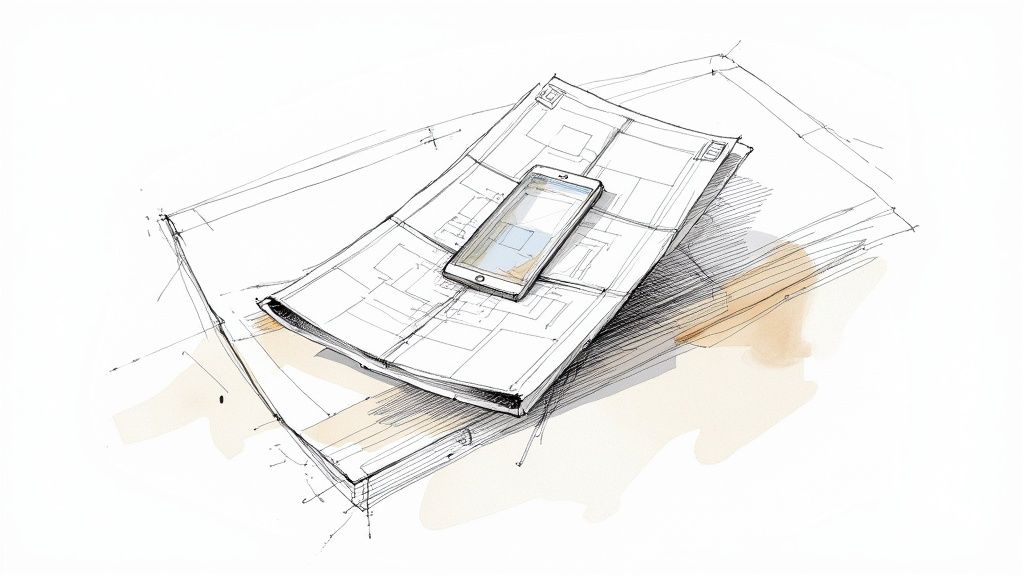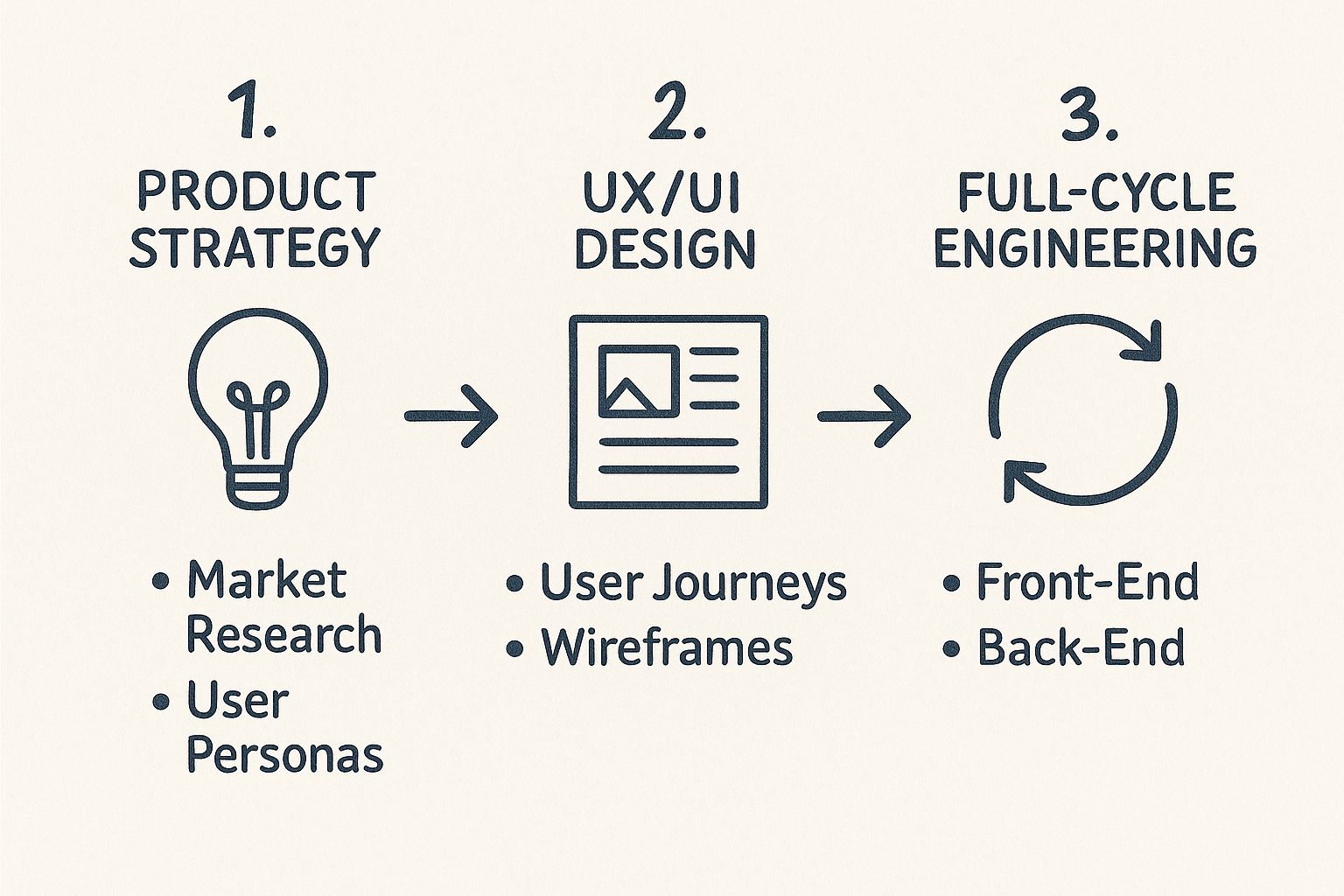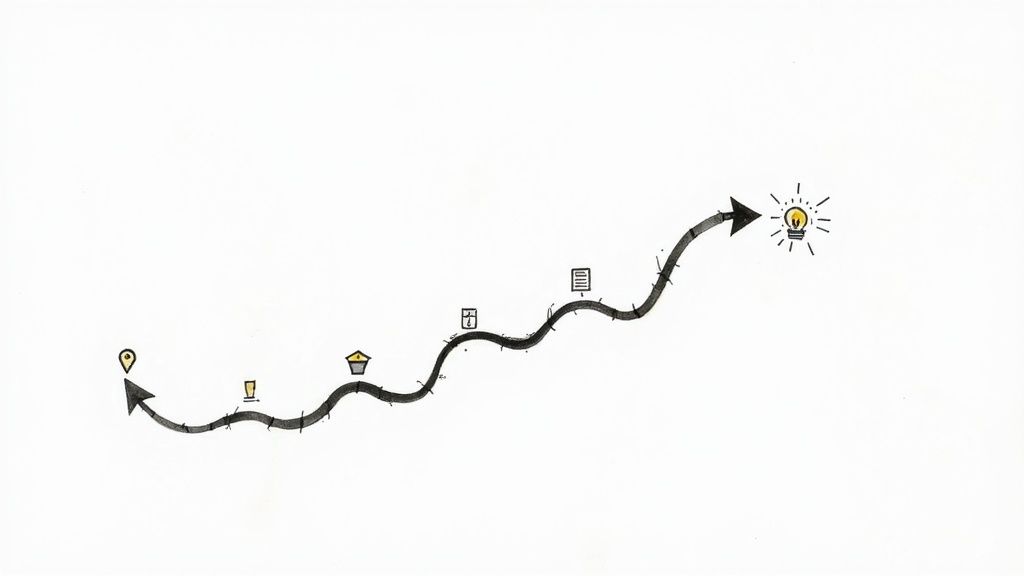Top Digital Product Development Company to Turn Ideas Into Reality
Partner with a leading digital product development company to transform your ideas into successful solutions. Discover expert services today!Have a great idea for a mobile app or a new piece of software? Turning that idea into something real and market-ready is a whole other challenge. That’s where a digital product development company comes in.
These specialized firms are more than just coders; they are strategic partners who take a concept from a rough sketch to a fully polished product that users love. They bridge the gap between a business goal and a tangible, user-friendly digital experience.
What Is a Digital Product Development Company?

Imagine you want to build a custom-designed house. You wouldn't just hire a bunch of carpenters and electricians and hope for the best. You'd bring in an architect to create the blueprints and a general contractor to manage the entire build from foundation to finish.
A digital product development company is exactly that for your software idea.
They don't just focus on one piece of the puzzle. They manage the entire journey, making sure every part works together perfectly. This is what separates them from a standard IT team that keeps internal systems running or a marketing agency that just promotes the final product.
The Architect and Contractor Analogy
Let's stick with the house-building analogy to see what they really do:
Designing the Blueprint (Strategy): An architect doesn't start pouring concrete without a plan. They study the land, understand how you'll live in the space, and draft a detailed blueprint. A development firm does the same with product strategy—they research the market, identify what users actually need, and create a solid roadmap. For example, they might conduct user interviews and find that your target audience values speed over features, leading to a leaner, faster product.
Laying the Foundation (UX/UI Design): A house with a shaky foundation is a disaster waiting to happen. In the digital world, that foundation is the User Experience (UX) and User Interface (UI). The team designs a product that's not just nice to look at, but also intuitive and easy to use. Actionable insight: Before coding, an interactive prototype is created, allowing you to click through the app and identify confusing navigation early on, saving thousands in rework.
Building the Structure (Engineering): This is the "construction" phase where the code gets written. The engineering team builds both the front-end (everything the user sees and interacts with) and the back-end (the brains of the operation running on a server). This is where designs become a working application.
Ensuring Quality and Safety (QA Testing): A building inspector makes sure everything is up to code and structurally sound. Similarly, the Quality Assurance (QA) team is dedicated to finding and squashing bugs. They test every feature to make sure the final product is reliable, fast, and glitch-free. Practical example: They'll test how the app performs on an older phone with a weak internet connection to ensure all users have a good experience.
This integrated process ensures that every decision—from the initial strategy to the final line of code—is aligned with the primary business objective and the needs of the end-user.
In the end, a digital product development company is your partner in innovation. They bring the expert team, proven process, and technical skill needed to turn a complex software idea into a successful reality. To get a closer look at how these pieces all fit together, you can dive into the complete digital product development process and see the journey from concept to launch.
The Core Services That Drive Product Success
So, what does a digital product development company actually do? They bring a handful of critical services together, making sure they all work in concert to build something great. These aren't just boxes to tick off a list; they're interconnected skills that transform a basic idea into a real, working tool that people will love to use. Getting this mix right is everything.
The whole process flows from one stage to the next, with strategy, design, and engineering all building on each other.

As you can see, each phase sets the stage for the one that follows. This ensures the final product isn't just well-built, but also smart and strategic from the ground up.
Product Strategy
Before anyone even thinks about writing code, you need a rock-solid foundation. Product Strategy is all about figuring out the "why" behind your product. It involves digging deep into market research, seeing what competitors are doing, and getting a crystal-clear picture of who your users are. The entire point is to define a real problem and make sure your solution is something people genuinely need.
Practical example: A startup wanted to build a new fitness app. Instead of creating a generic "me-too" product, their strategy phase uncovered a market gap: busy parents needing 20-minute, equipment-free workouts. This single insight became their unique selling proposition, shaping a product with a clear purpose and target audience.
UX/UI Design
Once the strategy is locked in, the focus shifts to how people will actually use the thing. UX/UI Design is where the product’s blueprint comes to life. This goes way beyond making it look pretty; it’s about designing a user journey that feels intuitive, simple, and even enjoyable.
A few key activities happen here:
- User Journey Mapping: This means mapping out every single step a person takes to get something done in your app.
- Wireframing and Prototyping: Designers create simple sketches and interactive mockups. This lets the team test the product's flow and iron out usability kinks long before a developer gets involved.
Actionable insight: An e-commerce site was losing customers at checkout. A UX/UI review revealed the process had too many steps. By redesigning it into a clean, single-page checkout, they reduced friction and saw an immediate 15% increase in completed sales.
Full-Cycle Engineering
This is where the vision gets real. Full-Cycle Engineering is the actual construction of the product, covering both the front-end (everything you see and click on) and the back-end (the hidden machinery like servers and databases). A great development partner manages this entire process, choosing the right technologies to make sure the final product is scalable, secure, and fast. This all-in-one approach is essential for successful custom web application development projects.
Quality Assurance
Finally, Quality Assurance (QA) is the gatekeeper that ensures the product is reliable and free of glitches. This isn't just a quick check at the very end; it's a constant process that happens all the way through development. QA engineers are tasked with trying to break things—testing every feature and interaction to catch bugs before they ever reach a real user. It’s what separates a professional, polished app from a frustrating, crash-prone one.
This integrated approach is paying off big time. Across industries, companies expect a 19% average increase in efficiency and a 17% reduction in time to market over the next five years just by adopting these kinds of modern development practices. You can read the full report on how digital transformation is boosting efficiency in product development on PwC.de.
Navigating the Product Development Journey

Bringing a digital product to life isn't a single, magical event. It's a carefully planned journey with clear milestones, and a professional development company acts as your expert guide. This structured approach helps turn a raw idea into a polished, market-ready solution while sidestepping the costly missteps that can derail a project.
Think of it like building a house. You don't just start throwing up walls. You need an architect's blueprint (design), a solid foundation (validation), a construction crew (development), and a final inspection (testing) before anyone can move in.
To give you a clearer picture, here's a quick breakdown of how these stages typically unfold.
Phases of the Digital Product Development Lifecycle
| Phase | Primary Goal | Key Deliverables |
|---|---|---|
| Ideation & Validation | Confirm the idea solves a real problem and has market potential. | Market research reports, competitor analysis, user personas, and an MVP scope. |
| Design & Prototyping | Create the visual and functional blueprint of the product. | Wireframes, high-fidelity mockups, interactive prototypes, and a complete UI/UX style guide. |
| Development & Testing | Write the code and ensure the product is bug-free and stable. | Functional front-end and back-end code, tested application builds, and bug reports. |
| Deployment & Iteration | Launch the product and continuously improve it based on feedback. | Live product on app stores or the web, performance analytics, and a roadmap for future updates. |
Each phase builds on the last, ensuring you have a solid foundation before moving forward. Let's dig a little deeper into what happens at each step.
Stage 1: Ideation and Validation
Every successful product starts with a spark of an idea, but an idea alone isn't enough. The first critical phase, Ideation and Validation, is all about pressure-testing that concept to see if it has real-world legs. This means digging into market research and competitive analysis to find where your product can uniquely fit.
You can't just assume people will want what you're building. The whole point here is to validate your core assumptions before a single dollar is spent on code.
A key tool for this is the Minimum Viable Product (MVP). This isn't a half-baked product; it's a strategic, lean version with just enough features to attract early users. Their feedback is pure gold, telling you what works and what doesn't.
Stage 2: Design and Prototyping
Once you've confirmed your idea is solid, the Design and Prototyping phase brings it into the visual world. This is where UX (User Experience) and UI (User Interface) designers step in to craft the product's look, feel, and flow. They're not just making things pretty; they're architecting an intuitive journey for your users.
Practical example: A prototype for a new banking app lets you click through the entire process of checking a balance or transferring funds. This interactive model helps stakeholders uncover confusing steps or clunky navigation long before the expensive development work starts. The entire process to develop an app really hinges on getting this visual foundation right.
Stage 3: Development and Testing
With a clear blueprint in hand, the Development phase kicks off. Here, software engineers turn the static designs into a living, breathing application. They write the front-end code that users see and interact with, and the back-end code that handles all the logic, data, and server operations behind the scenes.
Running in parallel is Quality Assurance (QA) Testing, a non-negotiable part of the process. QA specialists act as the ultimate critics, trying to break the app in every way imaginable. They test on different devices, simulate weird user behaviors, and hunt down bugs to ensure the final product is stable, secure, and works exactly as intended.
Stage 4: Deployment and Iteration
Deployment is the big day—your product's official launch! It goes live on the Apple App Store, Google Play, or the web for the world to use. But the work doesn't stop once you hit "publish." In fact, in many ways, it's just beginning.
The best products are never truly "done." The post-launch phase, known as Maintenance and Iteration, is a continuous cycle of gathering user feedback, analyzing performance data, and rolling out improvements. Actionable insight: If user data shows nobody is using a major feature, you can either improve its visibility or remove it to simplify the app—a decision driven by real behavior, not guesswork.
Why Partnering with an Expert Firm Makes Sense
So, you have a brilliant idea for a digital product. Now comes the big question: do you build an in-house team from scratch or bring in a specialized digital product development company? While keeping everything under your own roof sounds appealing, partnering with an expert firm often gives you a powerful head start and helps you sidestep some serious headaches.
Think of it like this: you're not just hiring a few people; you're getting an entire, battle-tested team on day one. You skip the long, expensive grind of recruiting, hiring, and training individual designers, engineers, and product managers. You get straight to building.
Faster Time-to-Market
The biggest win here is speed. A seasoned development firm doesn't need to figure things out as they go. They walk in with proven, refined processes that have been sharpened over dozens, if not hundreds, of projects. They already have the frameworks, communication tools, and project management systems locked in and ready to go.
This efficiency means a much faster time-to-market. For a startup, launching six months ahead of the competition can mean the difference between owning a market and just being another player. For a bigger company, it means getting value into your customers' hands sooner and seeing a return on your investment that much quicker.
Partnering with an external team isn't just about outsourcing tasks; it's about importing a mature, high-functioning system designed for one purpose: building and launching successful digital products efficiently.
The global product development industry is a testament to this, growing at a steady annual rate of 3.51%. With over 6.7 million employees and more than 475,000 new jobs added in the last year alone, the sector is an absolute powerhouse of innovation. When you partner with a firm, you're plugging into a massive well of shared knowledge and experience. You can find more insights about digital product trends on inviqa.com.
Cost-Effectiveness and Risk Mitigation
Hiring a full-time, in-house team is a huge financial commitment. It’s not just about salaries—you also have to factor in benefits, new equipment, office space, and continuous training. When you partner with a development company, you swap out that massive fixed overhead for a more flexible, project-based expense.
This approach offers some clear financial and strategic perks:
- Reduced Financial Burden: You avoid being locked into long-term salaries for specialists you might not need once the initial build is complete.
- Predictable Budgeting: Projects typically come with a clear scope, defined deliverables, and set timelines, which makes managing your money a whole lot easier.
- Minimized Risk: An experienced firm has seen it all. They know where the common traps are and how to avoid them, helping you steer clear of costly disasters related to bad architecture, security holes, or scalability problems.
Practical example: A founder without a deep technical background could easily sink their budget by choosing the wrong technology. Bringing in a partner with vetted experts takes that massive risk off the table, ensuring your product is built on a solid foundation (like choosing a scalable cloud infrastructure) right from the start.
How to Choose the Right Development Partner

Choosing a partner for your digital product is one of the most important calls you'll make. Get it right, and your vision turns into a market success. Get it wrong, and you're looking at blown deadlines and a product that just doesn't hit the mark.
This isn't just about hiring someone to code. It's about finding a team that truly gets what you’re trying to build and actively works to make it even better. Think of it less like hiring a contractor and more like bringing on a co-founder for your product. You need a team that shares your goals and has the chops to deliver.
Evaluate Their Portfolio and Industry Experience
The first stop is their portfolio. But don't just skim the pretty pictures. You need to dig deeper. A solid portfolio is proof of problems solved, not just screens designed. Actionable insight: Ask for a case study that shows not just the final product, but the business results—like "increased user retention by 25%" or "reduced customer support tickets by 40%."
Pay special attention to their experience in your industry. A team that’s already built successful fintech apps will instinctively understand the security and compliance headaches involved. That gives them a huge leg up over a team whose experience is limited to, say, e-commerce sites. Relevant experience means they’re speaking your language from the get-go.
Review Their Technology Stack and Processes
The tools a team uses say a lot about their expertise. Ask about their technology stack—the programming languages, frameworks, and databases they lean on. You want to make sure their choices fit your long-term plans for scaling the product and keeping it running smoothly.
Just as crucial is how they manage the project itself. Do they follow Agile or Scrum? These methods are built for flexibility, encouraging constant feedback and quick pivots. Practical example: In an Agile process, you review a working piece of the software every two weeks. This lets you catch misalignments early, like a feature that looks great but doesn't function the way you envisioned, preventing costly rework down the line. If you’re starting from scratch, seeing their experience as an MVP development agency can be a great indicator of their ability to build efficiently.
Assess Communication and Cultural Fit
Technical skills are only half the battle. A great partnership lives and dies by communication and culture. How do they take feedback? Are they upfront when things go wrong? Your ideal partner should feel like a natural extension of your own team, keeping you in the loop and solving problems with you, not for you.
A crucial takeaway is to seek a partner, not just a vendor. A true partner challenges your assumptions, pushes back on weak ideas, and invests in your success to build a better final product.
Don't just take their word for it—check their references. Reaching out to past clients for a quick chat is one of the best moves you can make. Ask them what the day-to-day collaboration was really like. This gives you the unfiltered truth and helps you find a digital product development company that will be a true champion for your project.
Measuring the Success of Your Digital Product
Getting your product out the door isn't the finish line—it's the starting gun. A great digital product development company knows the real work begins after launch. The goal is to build something with lasting value, and that's impossible if you're just guessing about what works.
Without data, you’re flying blind. Success isn't one big number; it's a story told through a handful of key performance indicators (KPIs). These are your product's vital signs, giving you the real-world insights needed to make smart decisions instead of just going with your gut.
Core Metrics Categories
To get a complete picture of your product's health, it's best to look at performance from three different angles. Each one answers a critical question about how you're doing.
User Engagement: Are people actually using what you built? And are they coming back? Metrics like Daily Active Users (DAU), how long people stick around each session, and which features they use most tell you if your product has that "sticky" quality. On the flip side, a high churn rate—where users try your product and leave—is a huge red flag that something in the experience is broken.
Business Impact: Is your product making a real difference to the bottom line? This is where you track hard numbers like Customer Lifetime Value (CLTV), conversion rates, and monthly recurring revenue (MRR). These metrics tie your product's performance directly to the financial health of your business.
Technical Performance: Is the product stable, fast, and reliable? Simple things like page load time, server uptime, and app crash rates are the foundation of a good user experience. If the tech is clunky, nothing else matters.
Actionable insight: Don't just track numbers; dig into the "why." If your data shows a sudden drop in engagement after an update, it’s a clear signal to survey those users. You might discover the "improvement" made a key feature harder to find, allowing you to quickly release a fix.
As technology keeps moving, so do the ways we build and measure products. Innovations in AI and automation are now shrinking modernization timelines by up to 50% and cutting delivery costs by about 40%, helping companies innovate faster than ever. You can find more on these digital transformation trends on coherentsolutions.com.
Understanding your metrics is the first step to making the most of these shifts. And if you want to get really granular on your acquisition costs, we've built a guide that includes a helpful customer acquisition cost calculator.
Got Questions? Here's What to Expect When Partnering Up
Deciding to bring in a digital product development partner is a big move. It’s an investment of not just money, but also trust and time. So, it's completely normal—and smart—to have some practical questions before you sign on the dotted line.
Getting these common concerns sorted out early is the best way to make sure everyone's on the same page for a smooth and successful project. Let's dive into the questions we hear most often.
What's the Real Cost of Building a Digital Product?
The honest, no-fluff answer? It really depends. The price tag for a digital product is tied directly to how complex it is. A lean Minimum Viable Product (MVP) focused on just the essential features might land in the tens of thousands. On the other hand, a sophisticated enterprise platform with heavy-duty integrations could easily climb into the hundreds of thousands, or even more.
To give you a predictable way to manage the budget, most firms offer a couple of standard pricing models:
- Fixed-Price: Perfect for projects with a crystal-clear scope that isn't likely to change. You agree on one total cost for the entire project, giving you complete budget certainty from the start. Best for: A simple marketing website or a small internal tool.
- Time & Materials (T&M): With this model, you pay for the actual time spent on your project, usually at an hourly or daily rate. It’s the go-to choice for complex builds where you know requirements will probably shift and evolve along the way. Best for: A new SaaS product where user feedback will shape future features.
How Long Will This Actually Take?
Much like the cost, the timeline is all about the scope. We've seen straightforward mobile app MVPs go from concept to launch in a tight 3-6 months. But if you're building a feature-packed application or an intricate SaaS platform, you should realistically plan for a timeline closer to 9-12 months, sometimes longer.
A good partner won’t just give you one big, scary deadline. They'll break the entire project down into smaller, manageable milestones. This not only makes the process feel less overwhelming but also gives you clear checkpoints to see that real, steady progress is being made.
The most important thing here is transparency. A partner you can trust will give you a detailed project roadmap with realistic time estimates for every single phase, from the first sketch to the final launch.
Who Owns the Code and Designs When It's Done?
This one is critical, but the answer should be simple and non-negotiable: you do. When you hire a professional development firm, the contract must state that 100% of the intellectual property (IP) belongs to you. That includes every line of source code, all the design files, and anything else created for your project.
This isn't a special perk; it's standard operating procedure. The company is a service provider you've hired to create an asset for your business. Before any work kicks off, double-check that your contract spells this out clearly for total peace of mind.
Ready to turn your idea into a market-leading product without the guesswork? Pixel One specializes in transforming complex challenges into scalable digital solutions. Let's build something great together.